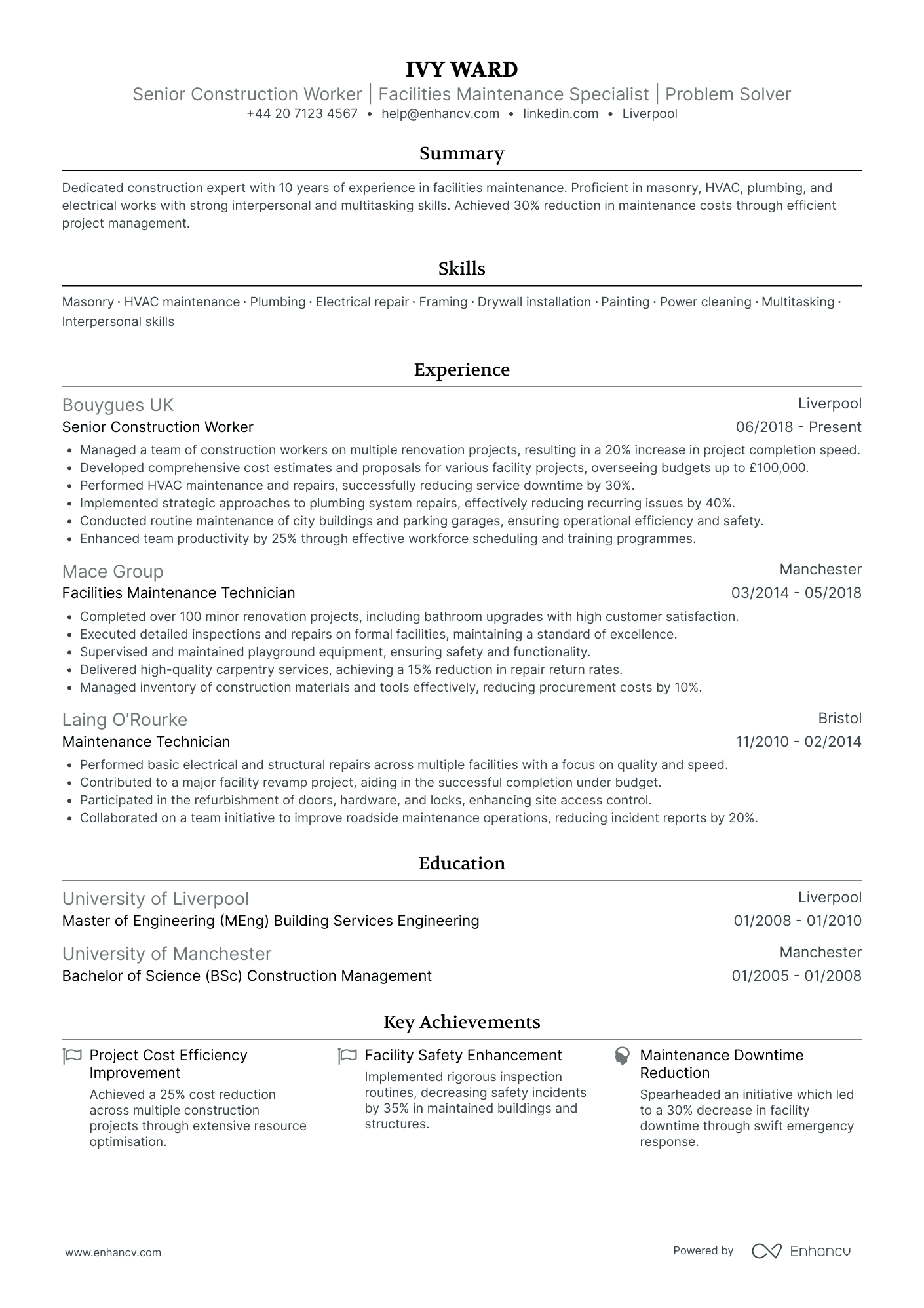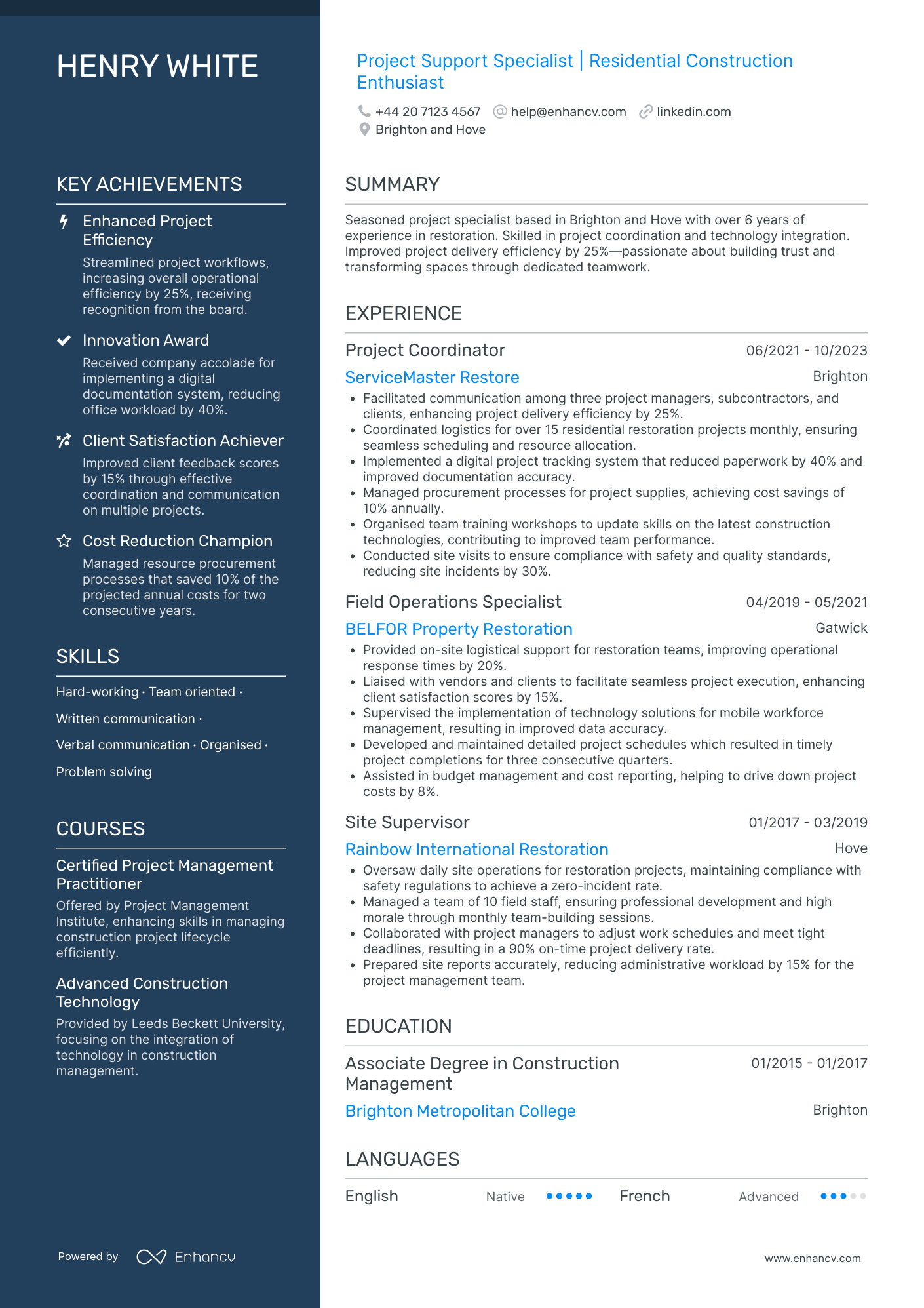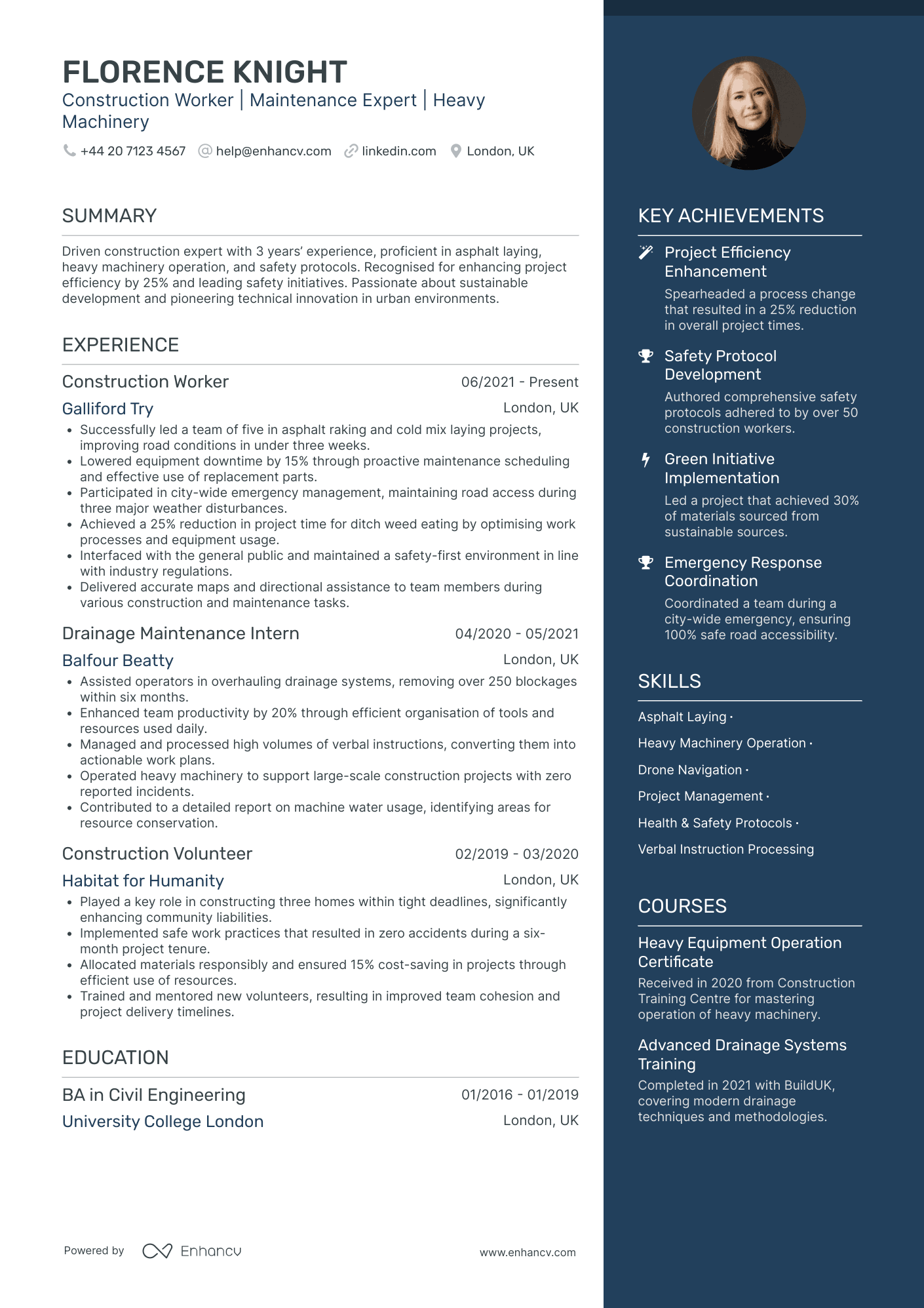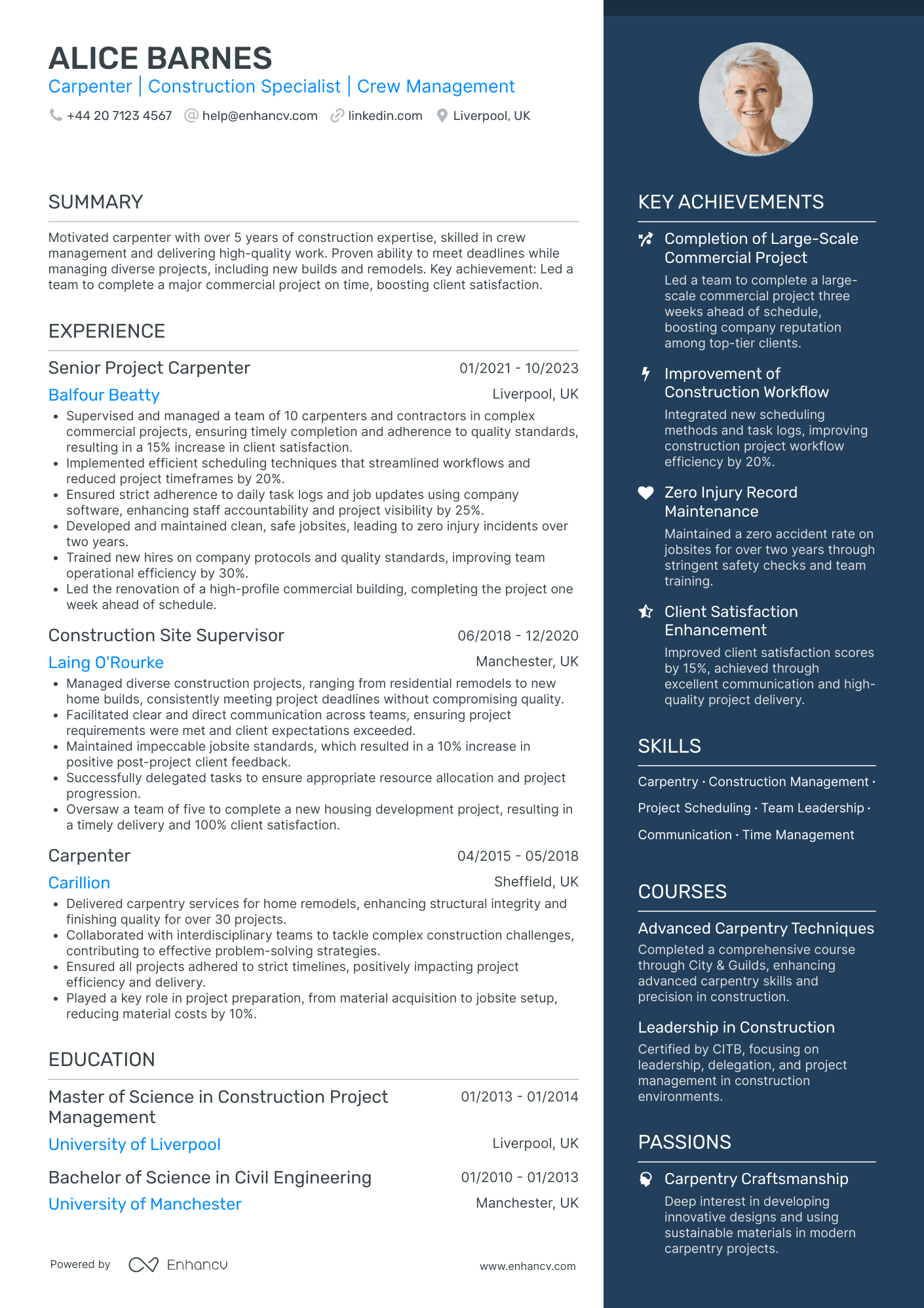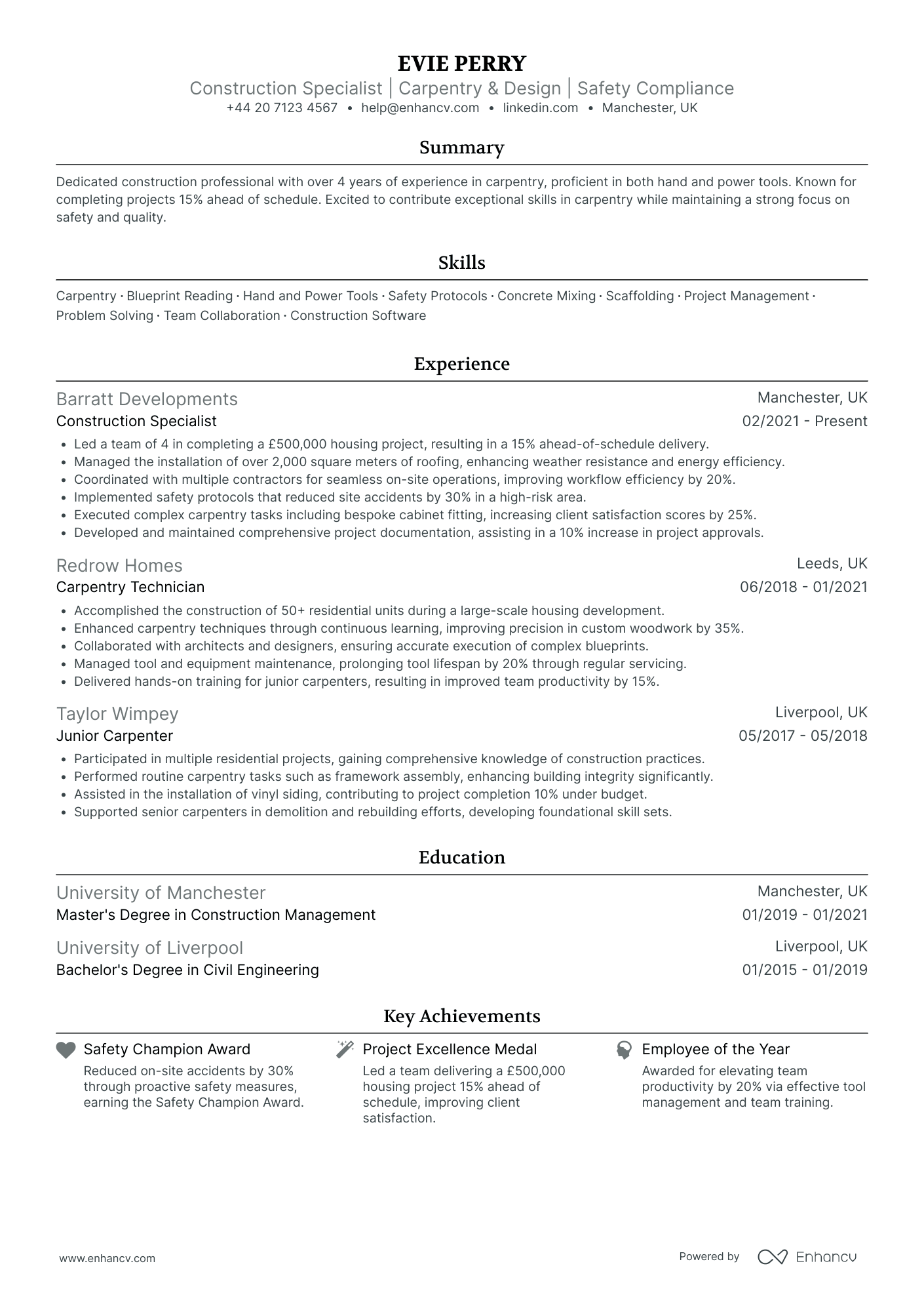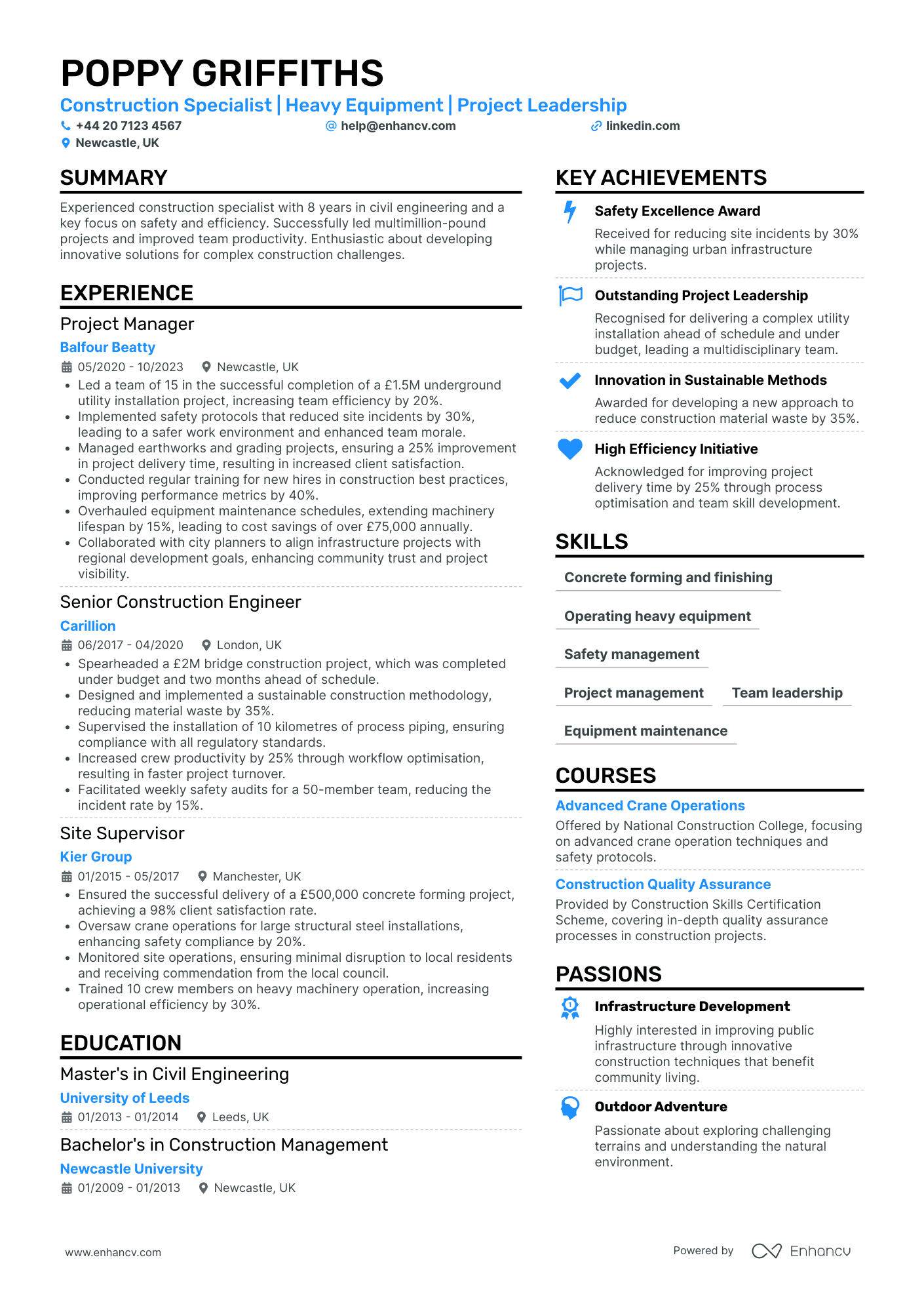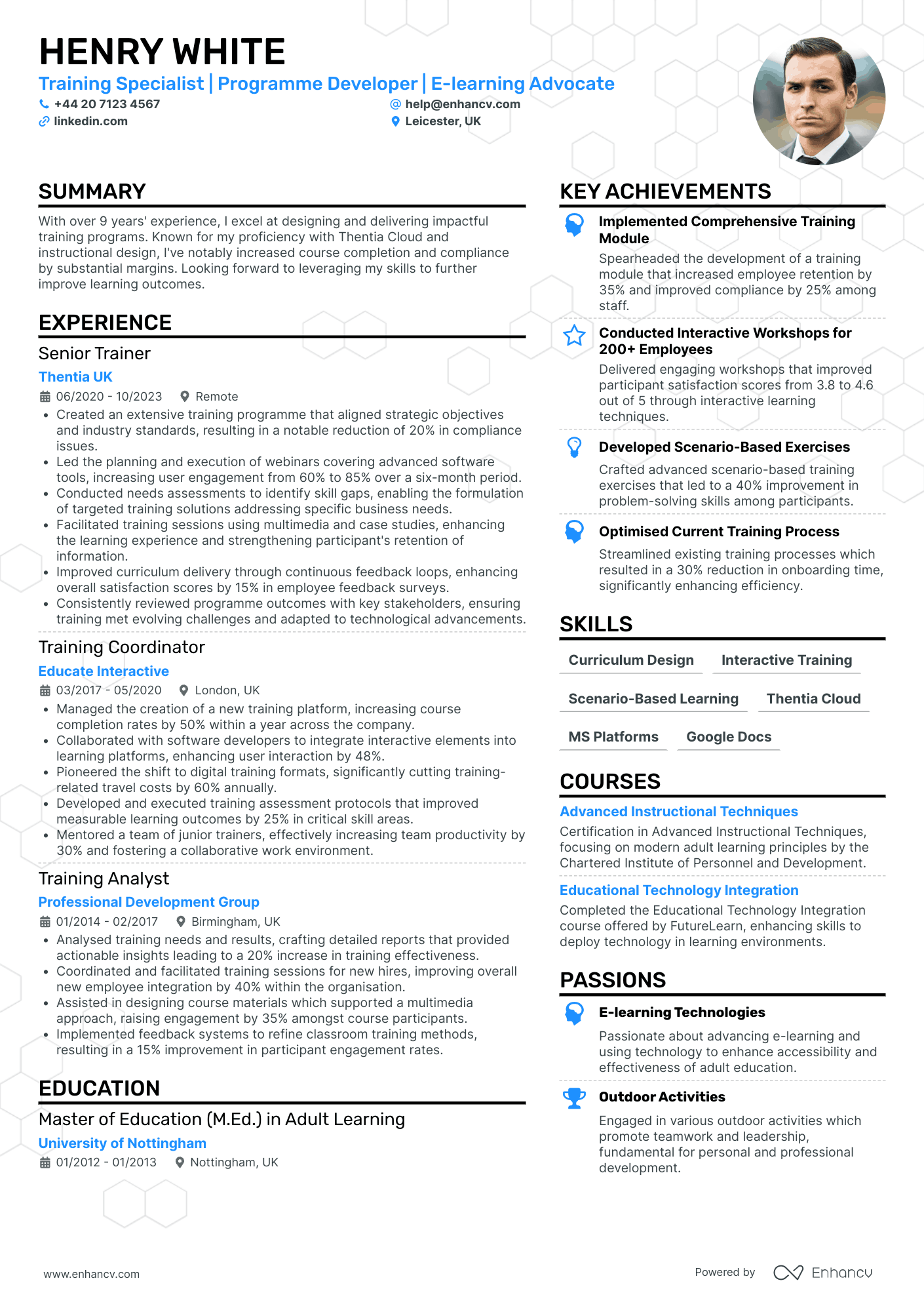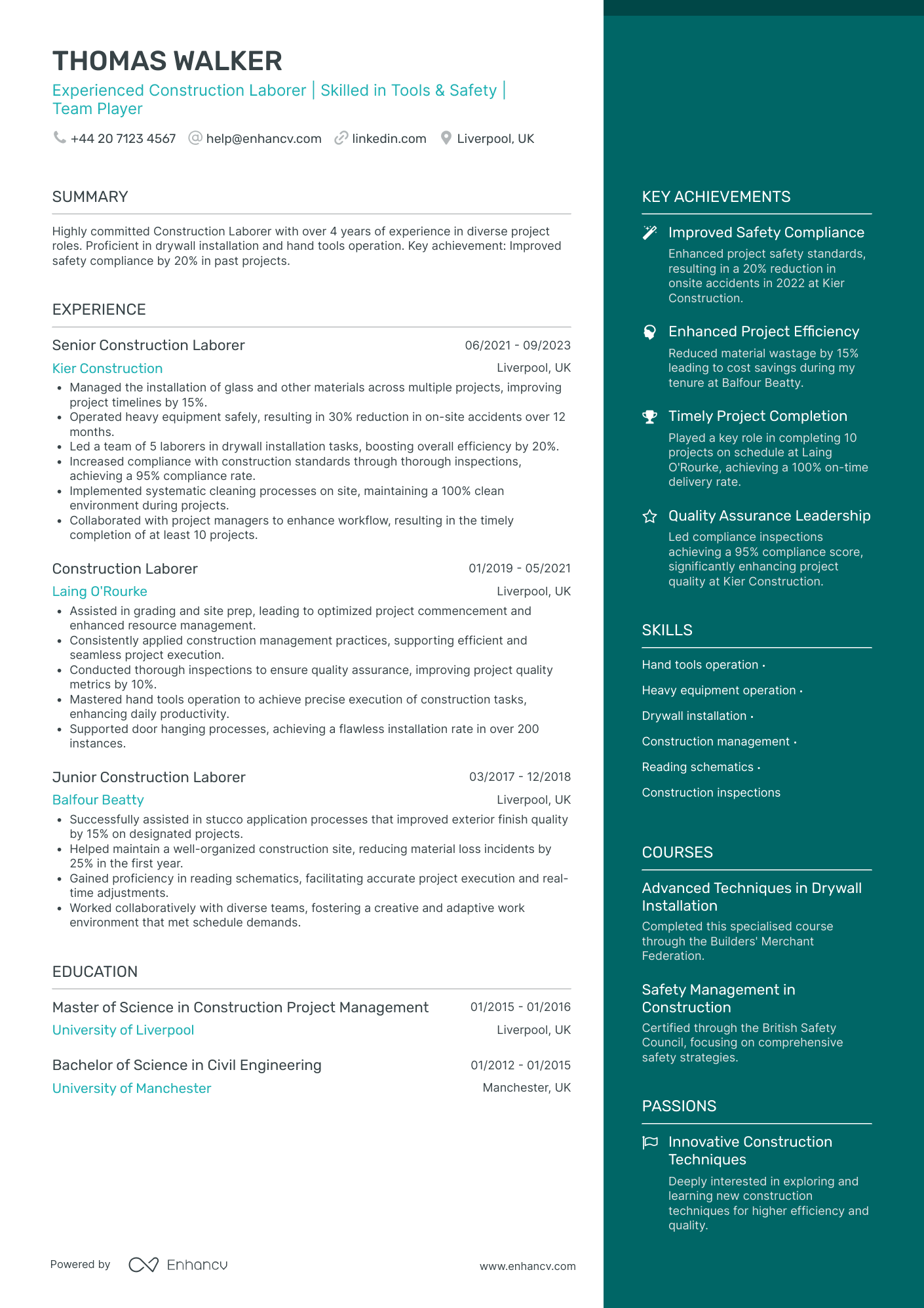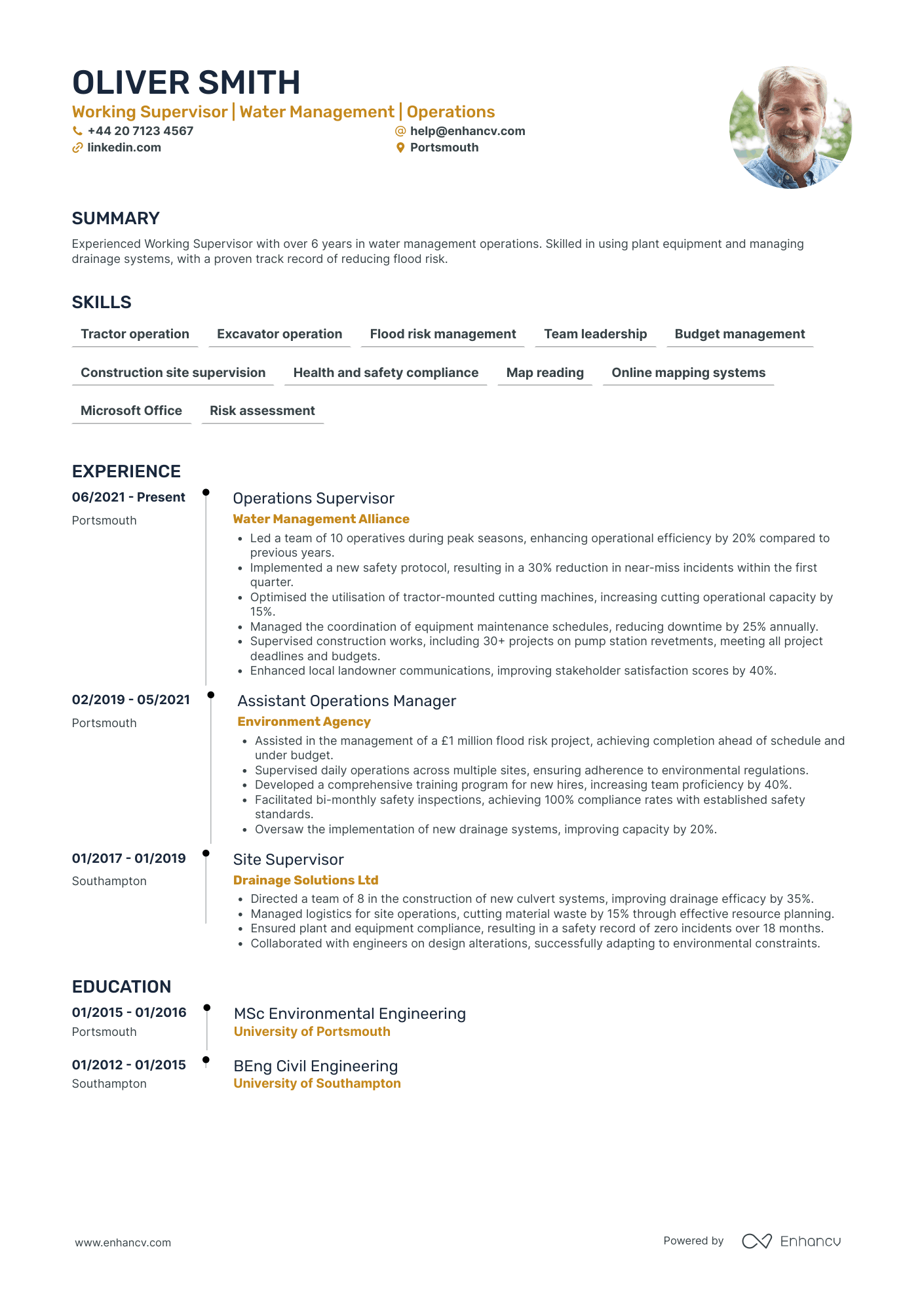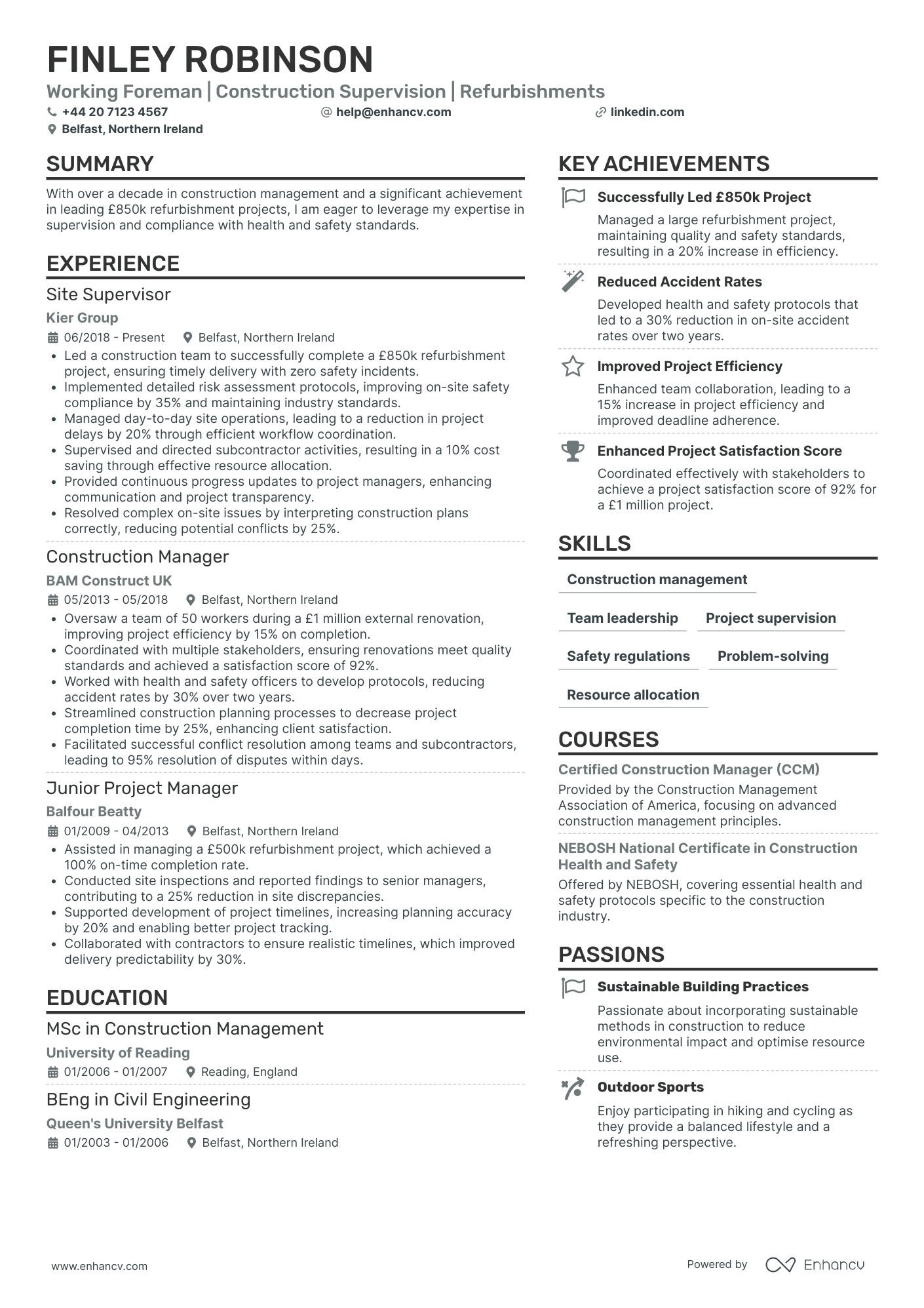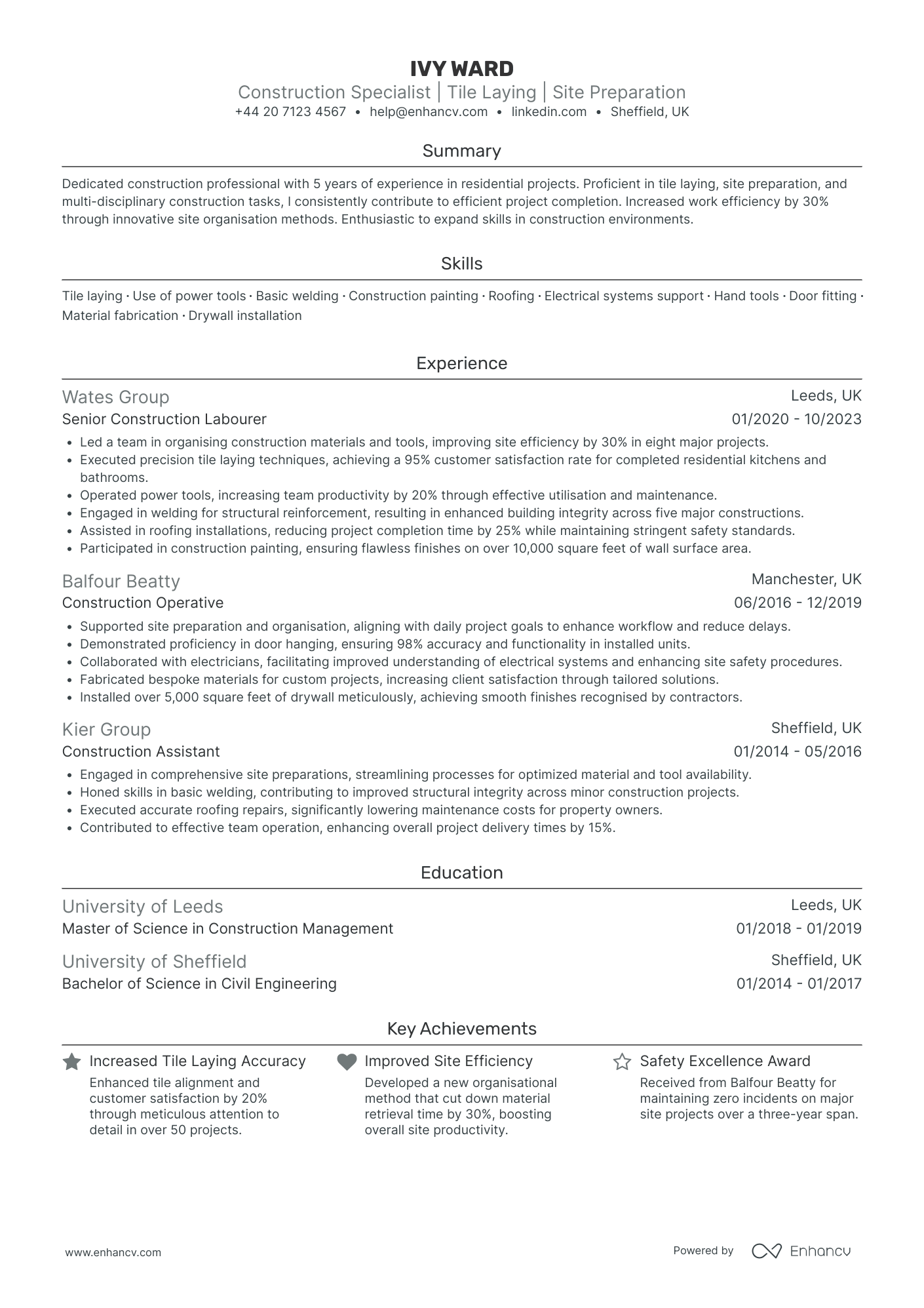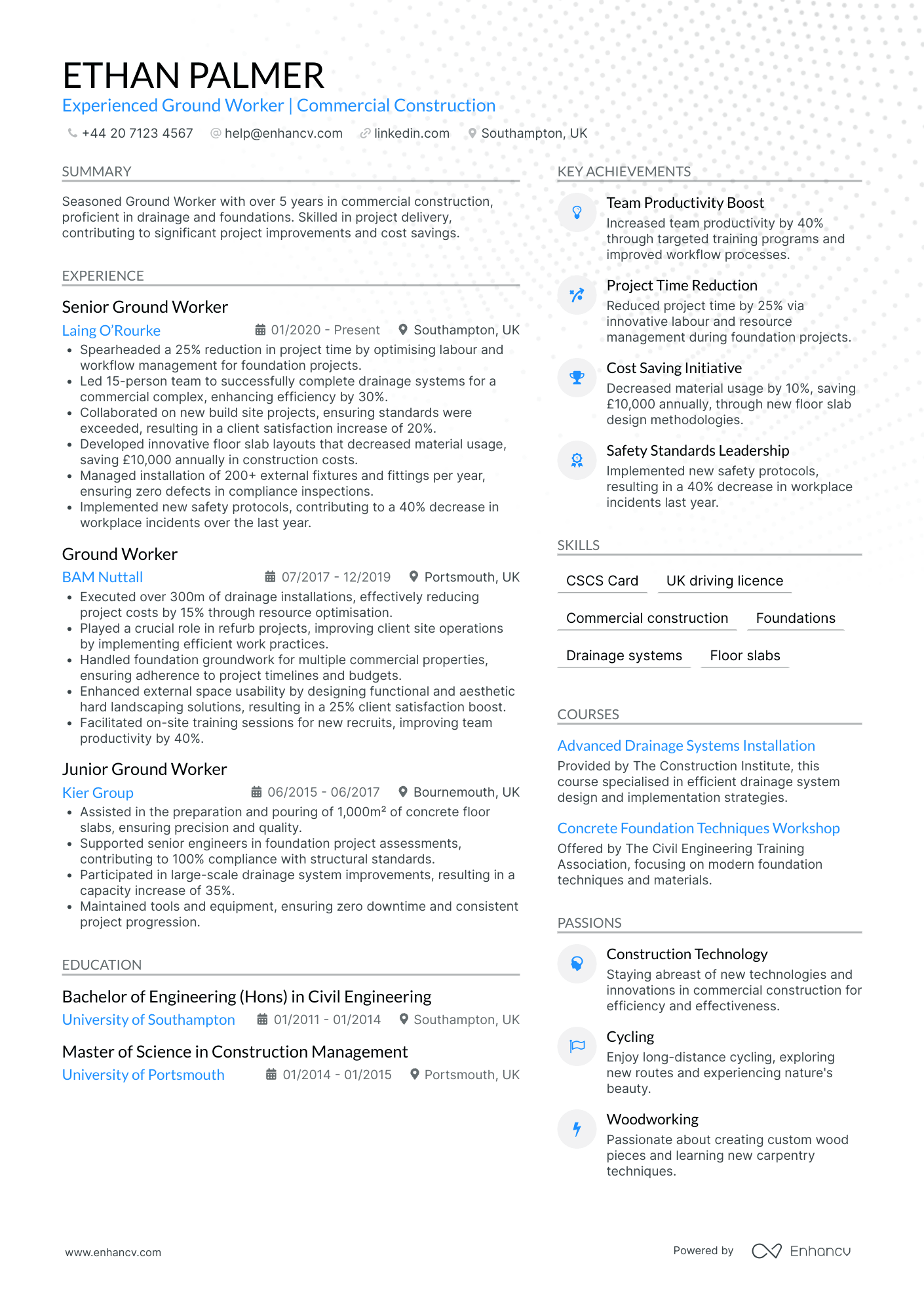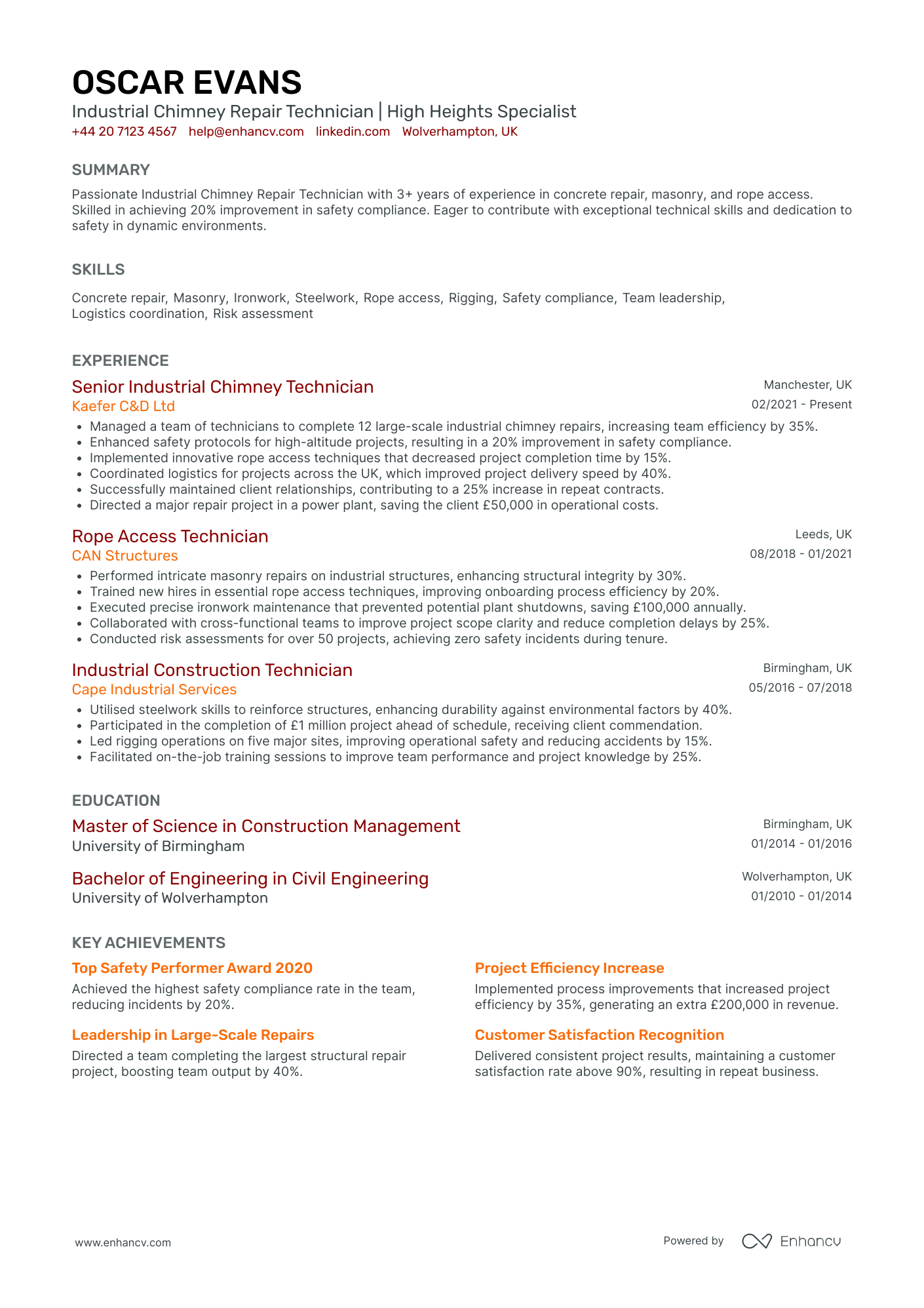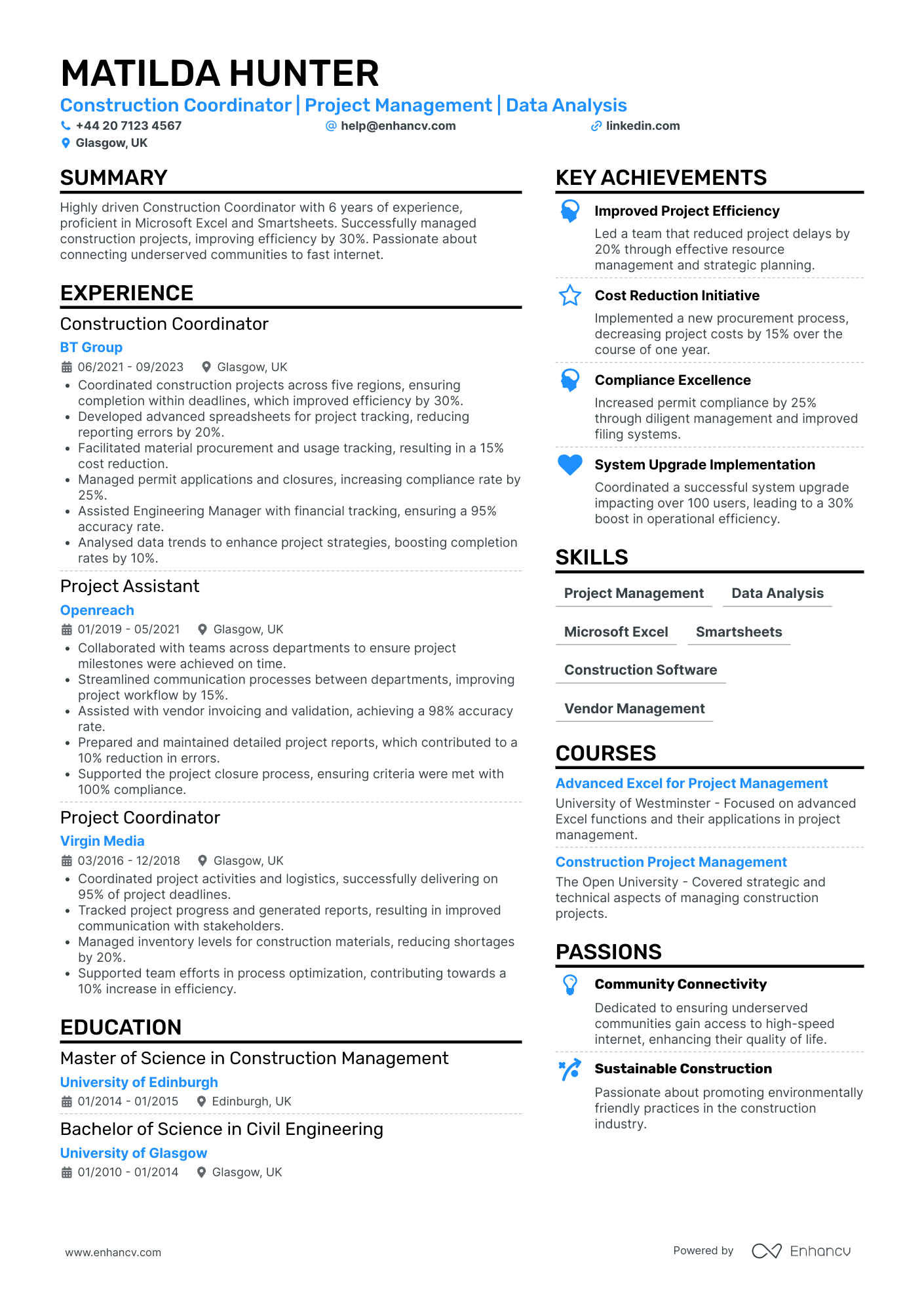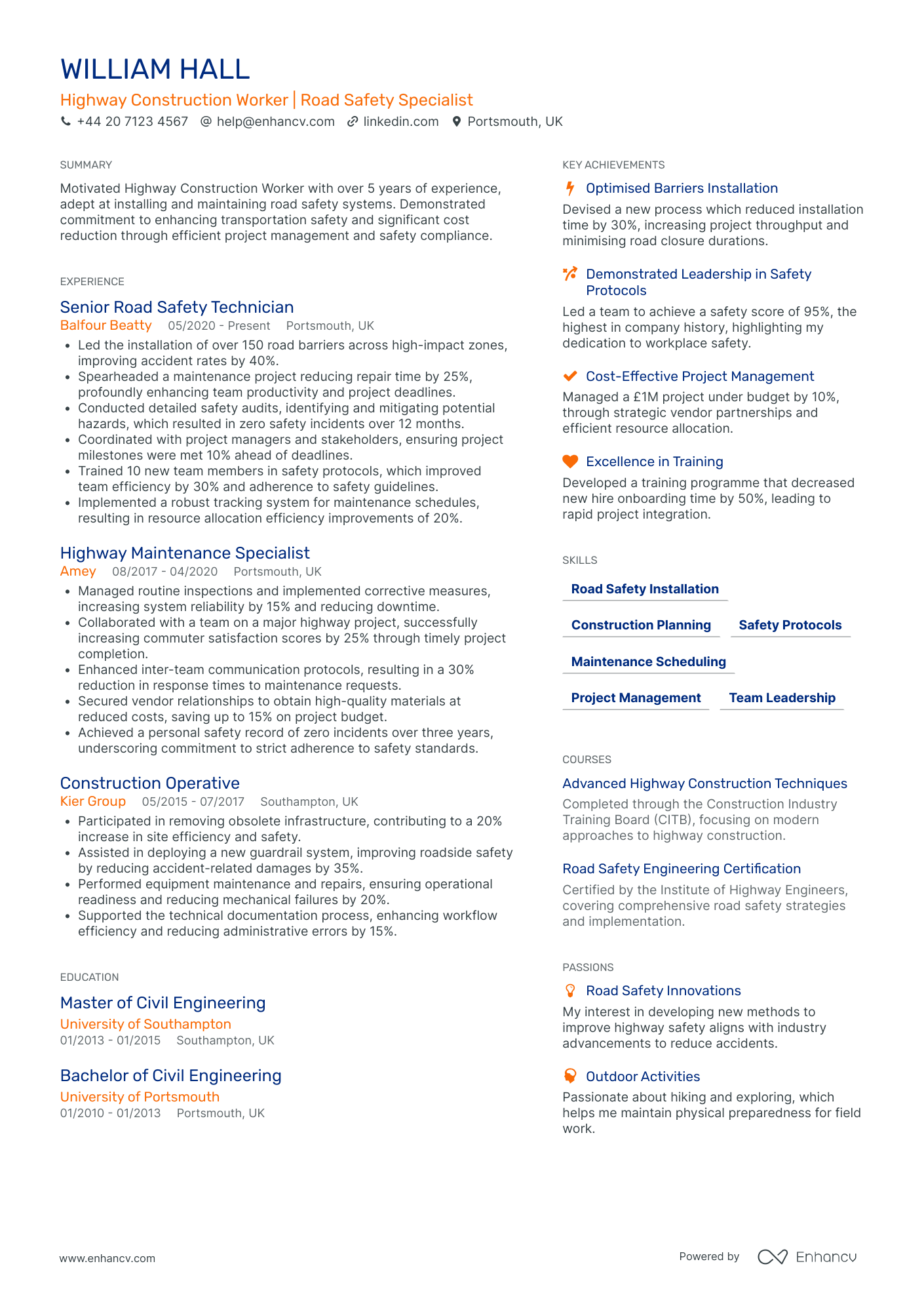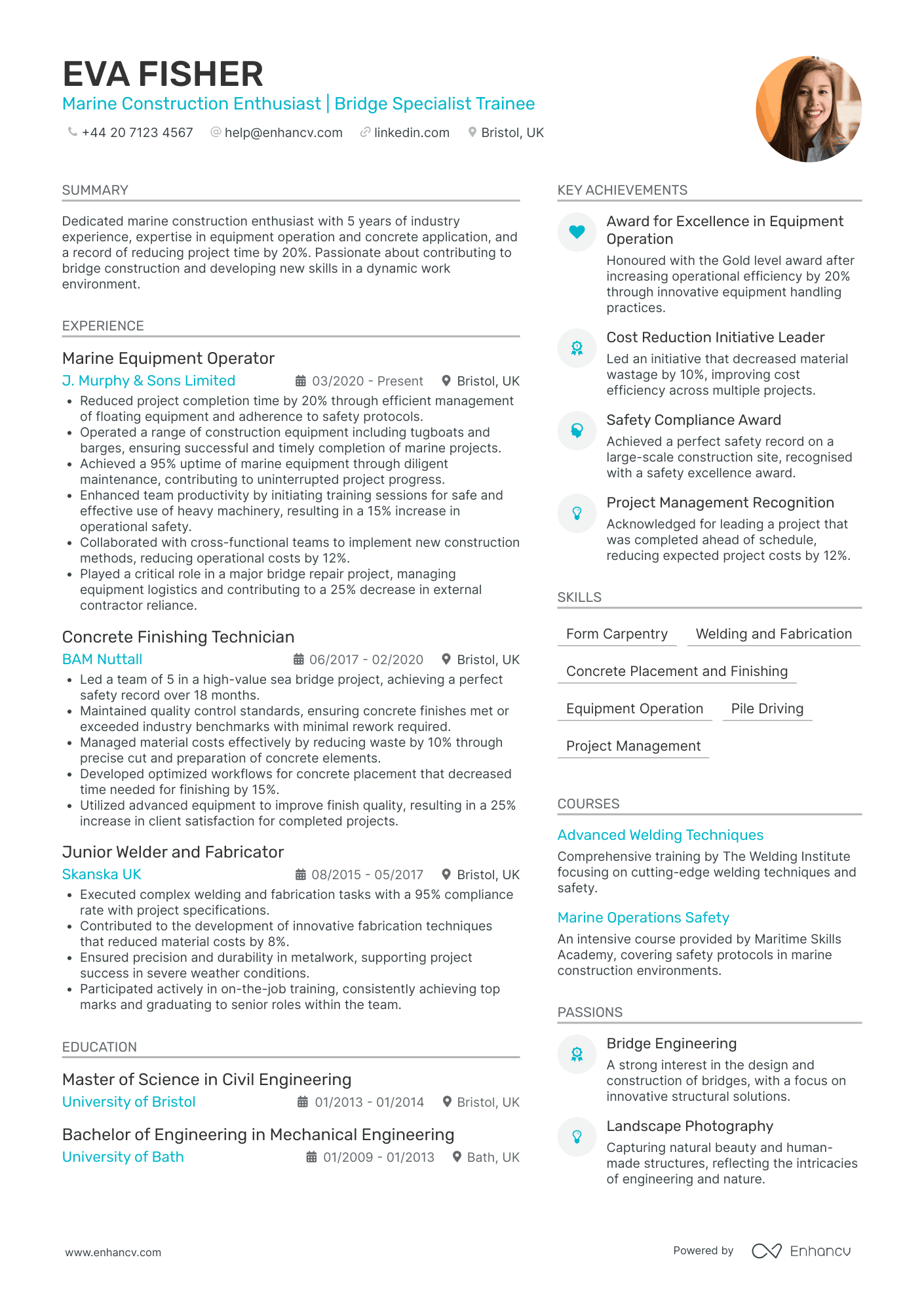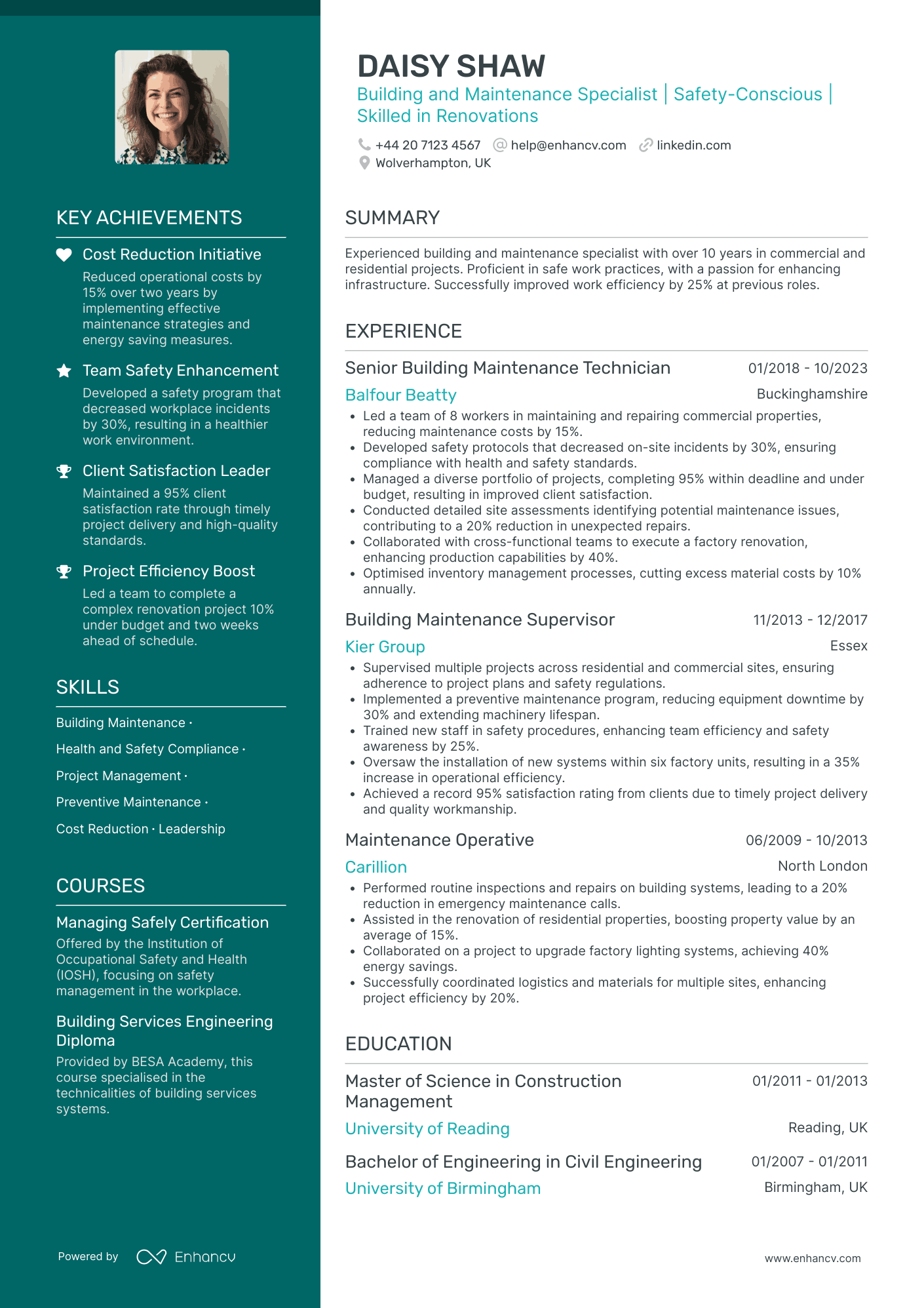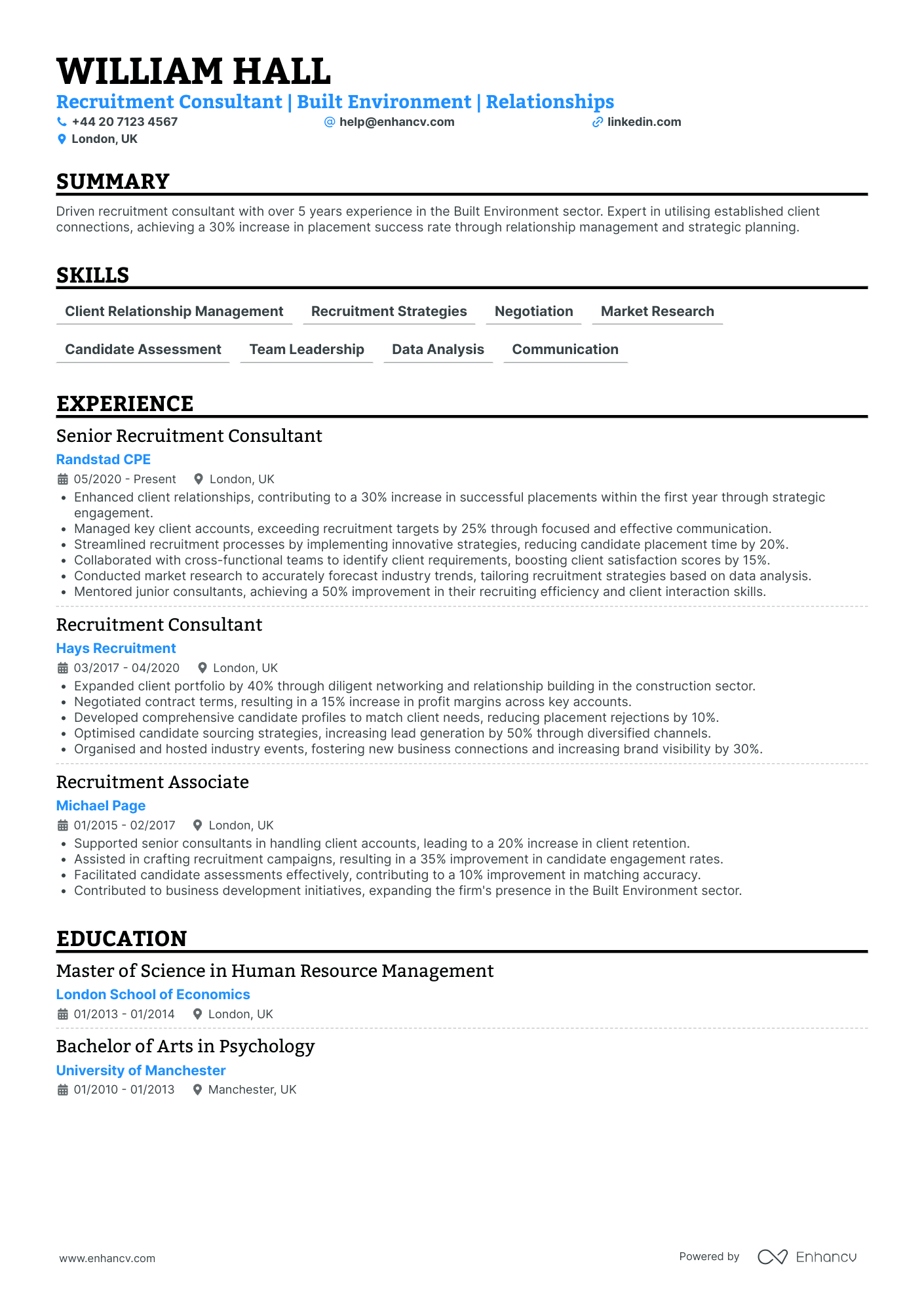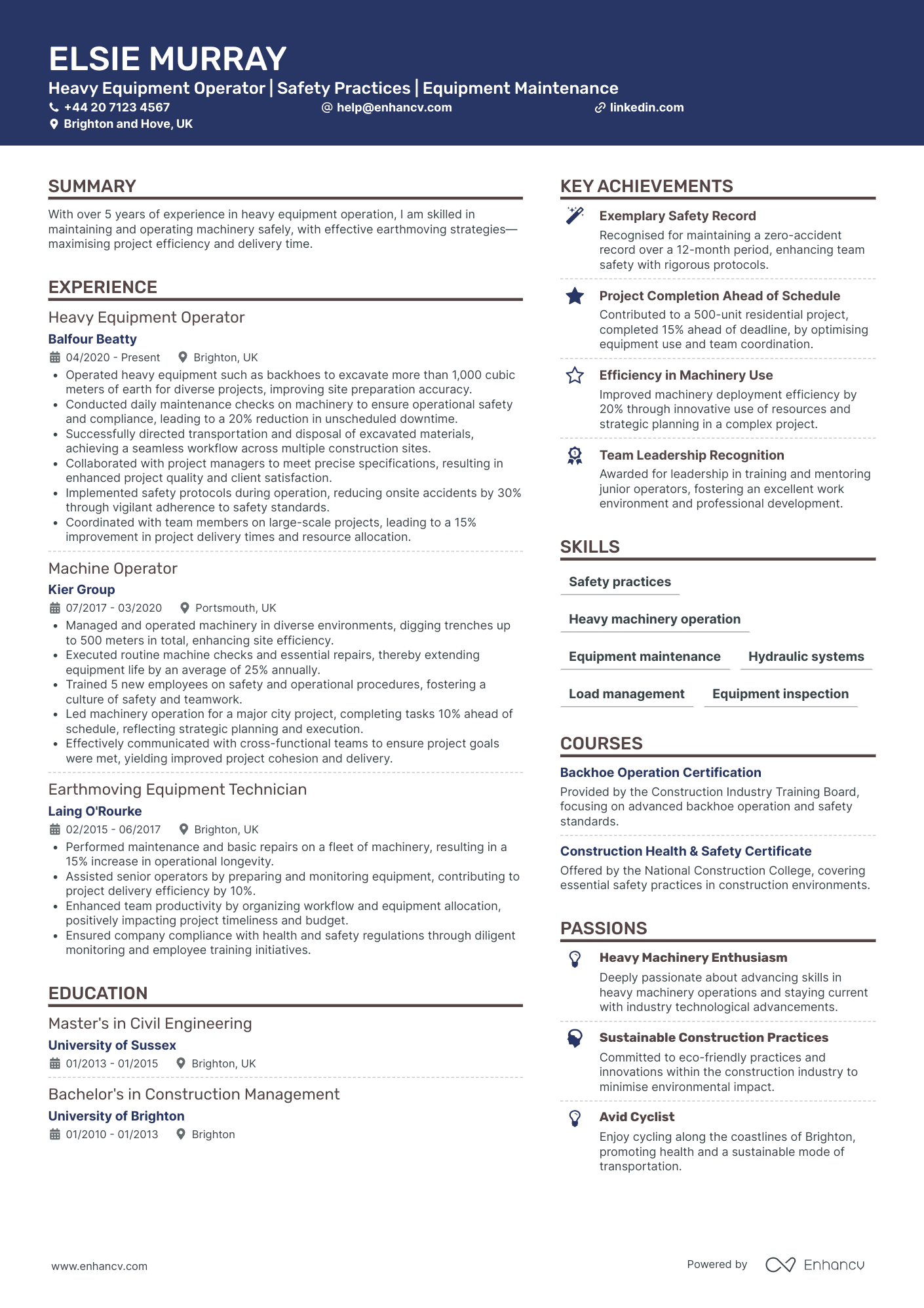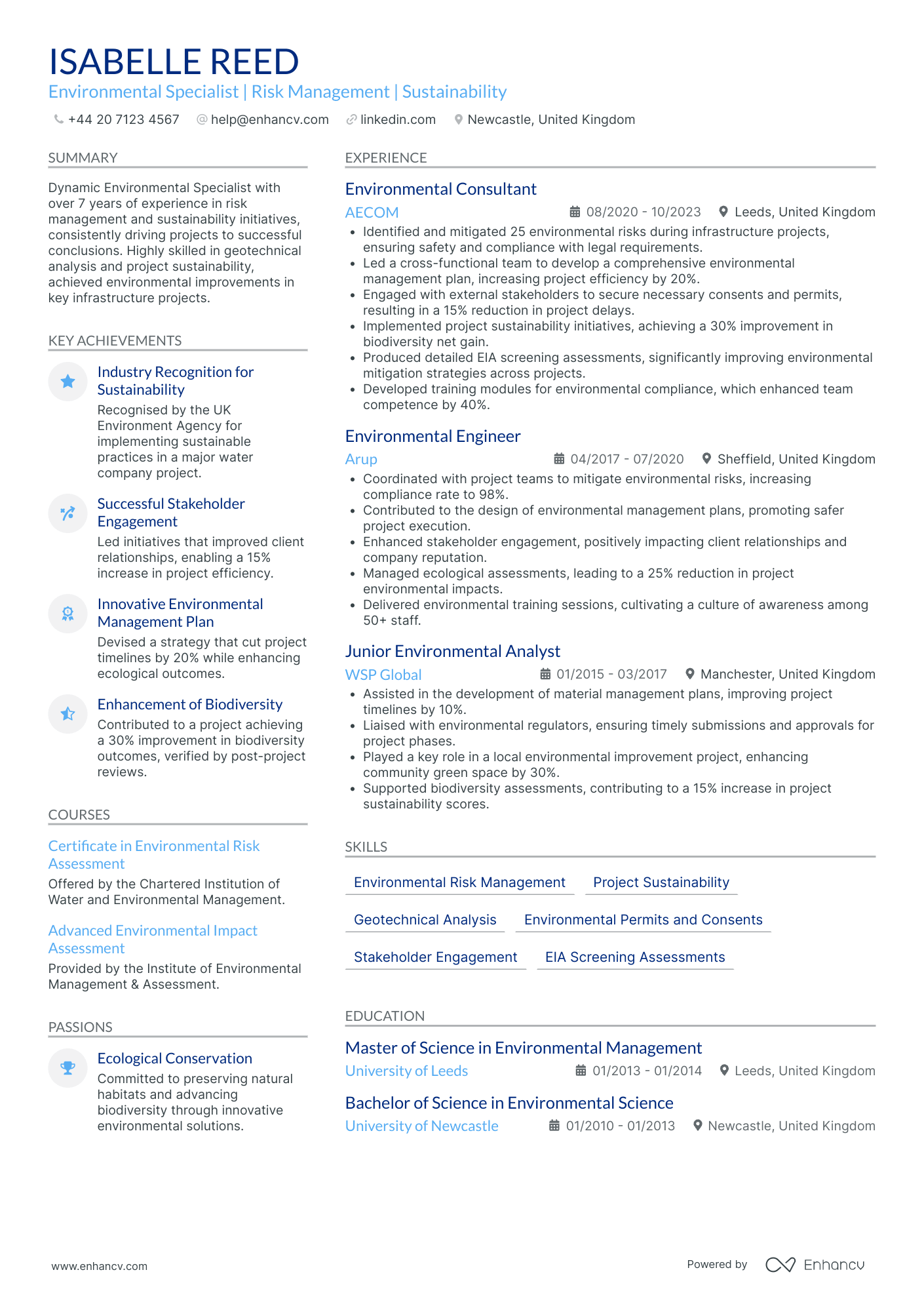Crafting a CV that effectively showcases your practical skills and on-site experience can be a daunting challenge for construction workers. Our guide provides clear, step-by-step advice to help you translate your hands-on expertise into a compelling written format that will catch the attention of potential employers.
- Create an attention-grabbing header that integrates keywords and includes all vital information;
- Add strong action verbs and skills in your experience section, and get inspired by real-world professionals;
- List your education and relevant certification to fill in the gaps in your career history;
- Integrate both hard and soft skills all through your CV.
Discover more industry-specific guides to help you apply for any role in the links below:
Resume examples for construction worker
By Experience
Senior Construction Worker
- Clear structure with targeted sections - The CV is meticulously organized with well-defined sections such as experience, education, skills, courses, achievements, and languages. This clear segmentation not only enhances readability but also ensures that the pertinent information is easily accessible, making it ideal for recruiters looking for specific qualifications and experiences.
- Significant career progression in construction and maintenance - Ivy Ward's career trajectory illustrates solid growth within the construction industry, having advanced from a Maintenance Technician to a Senior Construction Worker. Her increasing responsibilities and leadership roles reflect her ability to manage larger projects and teams, culminating in her current role's strategic input in project execution and management.
- Demonstrates adaptability and cross-functional impact - Throughout her career, Ivy has showcased an ability to adapt to various roles within the construction and maintenance sectors, evidenced by her experience in both technical repairs and team management. Her skillset spans multiple domains, such as HVAC and electrical repairs, which speaks to her versatility and capability to handle diverse challenges effectively.
Assistant Construction Worker
- Clear Communication and Structured Presentation - The CV's structure facilitates easy navigation, with distinct sections highlighting key qualifications, experience, and achievements. Bullet points under each job role concisely outline responsibilities, emphasizing Henry's skills in project coordination and technology integration, which are crucial in his field. This clarity ensures potential employers can quickly grasp his expertise and professional journey.
- Industry-Specific Expertise and Adaptability - Henry’s detailed knowledge in residential construction is underscored by his role as a Project Support Specialist and his passion for transforming residential spaces. His career shows a consistent focus on residential restoration, augmented by the ability to integrate technology solutions. This combination of industry-specific knowledge and tech-savvy adaptability positions him as a forward-thinking professional in his niche.
- Impactful Achievements with Real Business Benefits - The CV effectively links accomplishments to business outcomes, like cutting project delivery time by 25% and reducing costs through strategic procurement by 10%. These results demonstrate Henry's capacity to influence project efficiency and overall company performance positively, making his contributions valuable to prospective employers.
Junior Construction Worker
- Effective Structuring of CV Content - The CV is structured with clarity and precision, showcasing a well-organized format where each section builds upon the previous one. The use of bullet points provides concise information for easy readability, highlighting Florence Knight's skills and achievements promptly while avoiding overwhelming the reader with excessive details.
- Diverse Career Development - Florence's career trajectory demonstrates a steady progression within the construction industry marked by increased levels of responsibility. From a volunteer position to leading teams as a Construction Worker, this upward movement reflects both personal development and recognition within the field for her growing expertise and capability in handling more complex tasks.
- Specific Industry Expertise - The CV includes detailed insights into Florence's expertise with heavy machinery and technical methodologies, such as asphalt laying and drainage maintenance, showcasing a solid grasp of technical operations. Her mastery of complex machinery operations and her contribution to efficient project execution underline her deep-rooted technical knowledge that is vital in her field.
Lead Construction Worker
- Skillful organization and clarity in presentation - The CV is well-structured, presenting key sections such as experience, education, skills, and achievements in an easily digestible format. The use of clear bullet points under experience highlights specific responsibilities and accomplishments, allowing employers to quickly assess the candidate's suitability.
- Career progression demonstrating leadership - The candidate shows a clear upward trajectory in their career, moving from a Carpenter to a Senior Project Carpenter over a span of eight years. This progression not only demonstrates their growing expertise but also highlights their ability to lead teams and manage complex projects in the construction industry.
- Unique focus on construction management and safety - The CV emphasizes the candidate's mastery of industry-specific tools and methodologies, with achievements such as maintaining a zero injury record and enhancing construction workflows by 20%. This focus on safety and efficiency is critical in the construction sector, reflecting their deep technical depth and commitment to best practices.
Construction Worker Apprentice
- Structured Career Advancement - Evie Perry's CV clearly outlines a logical career progression, starting as a Junior Carpenter and advancing to the role of Construction Specialist. This trajectory showcases her growth within the construction industry, emphasizing increased responsibilities and leadership roles over time.
- High-Impact Safety and Efficiency Initiatives - The CV emphasizes Evie Perry's focus on improving safety and efficiency in construction projects. Notable achievements include reducing on-site accidents by 30% and delivering a £500,000 housing project 15% ahead of schedule, clearly demonstrating her ability to implement impactful solutions that benefit both workers and project timelines.
- Integration of Modern Techniques and Tools - By highlighting both traditional carpentry skills and modern methodologies, Evie Perry's CV stands out in its ability to blend time-tested techniques with innovative approaches. Her expertise in both hand and power tools, coupled with the integration of advanced carpentry techniques, marks her as a versatile professional capable of tackling diverse challenges within the field.
Skilled Construction Worker
- Progressive Career Development - Poppy Griffiths' CV showcases a consistent upward trajectory in the construction industry, with advancement from Site Supervisor to Project Manager. This progression illustrates a strong career development path, highlighting her capacity to take on increasing levels of responsibility and complexity in project management.
- Demonstrated Leadership and Team Development - Throughout her career, Poppy has consistently shown strong leadership skills, proven by her ability to lead multidisciplinary teams on high-value projects. Her efforts in training new hires and optimizing workflows reflect a commitment to developing team efficiency and capacity building.
- Emphasis on Safety and Sustainability - The CV is notable for its focus on safety and sustainable construction methodologies, crucial elements in the industry. Poppy's achievements in reducing site incidents by 30% and her innovative approach to minimizing material waste demonstrate a deep commitment to both safety and environmental responsibility.
By Role
Construction Worker Trainer
- Clear and Structured Content Presentation - The CV excels in clarity and structure, with distinct sections for achievements, experience, education, and skills that are presented concisely. Each accomplishment and responsibility is detailed with precise language, ensuring the reader can quickly grasp the candidate's qualifications and relevance to the role.
- Dynamic Career Trajectory - Henry White’s career path shows a consistent growth pattern, moving from Training Analyst to Senior Trainer while expanding responsibilities and scope. This progression indicates a deepening expertise and a proactive approach to career development within the training and e-learning sector.
- Emphasis on Real-World Impact - The achievements specified in the CV not only include quantitative improvements, such as a 35% increase in employee retention, but they also address broader business challenges like compliance and integration, showcasing the significant impact Henry has made in organizational contexts.
Construction Site Worker
- Structured presentation and clarity - The CV is thoughtfully organized, with distinct sections for experience, education, and achievements that provide a clear narrative of the candidate's expertise and career journey. Each role is presented in a concise manner, highlighting key responsibilities and accomplishments without overwhelming detail, making it easy for employers to identify the candidate's strengths and suitability for the position.
- Consistent growth and role expansion in the construction industry - The career trajectory is marked by significant growth, advancing from a Junior Construction Laborer to a Senior position within six years. This progression demonstrates not only the acquisition of technical skills and expertise but also increasing leadership responsibilities, as seen in roles that involve managing teams and improving project workflows.
- Focus on safety and quality in construction methodologies - The CV emphasizes industry-specific elements such as proficiency in operating heavy equipment, drywall installation, and construction inspections. Notably, the candidate has a dedicated focus on safety compliance, which is crucial in construction environments, and has achieved a substantial reduction in on-site accidents, indicating a strong understanding of both practical and regulatory aspects of construction.
Construction Worker Supervisor
- Clear and structured presentation - The CV is well-organized, presenting each section in a logical flow from personal details to work experience, education, skills, and achievements. The clarity in structure helps readers easily navigate through the candidate’s qualifications and experiences without missing key information.
- Progressive career trajectory - Oliver's career progression from Site Supervisor to Operations Supervisor reflects significant growth in leadership and responsibility within the water management sector. This trajectory shows the ability to adapt and excel in increasingly complex roles, indicating strong potential for further advancement.
- Industry-specific expertise and tools - The CV includes specific tools and methodologies such as tractor and excavator operation, as well as flood risk management techniques, which are crucial in water management. This technical depth showcases Oliver's hands-on experience and operational competence, making him highly relevant for supervisory roles in this niche industry.
Construction Worker Foreman
- Comprehensive Visual Structure - The CV exhibits a clear and concise structure, ensuring information is accessible and easy to navigate. Each section is distinct, with headings such as "Experience," "Education," and "Skills" well-organized, facilitating a smooth reading experience.
- Progressive Career Development - The career trajectory of Finley Robinson demonstrates consistent growth and increased responsibility over time. Starting as a Junior Project Manager and advancing to Site Supervisor and Construction Manager showcases a strong path of promotions and skill development within the construction industry.
- Demonstrated Leadership and Impact - Finley Robinson's CV highlights not only leadership but also the significant impact of work through measurable achievements, such as leading to a 30% reduction in accident rates and improving project efficiency by 15%. These metrics underscore the tangible business value he has provided to past employers.
Residential Construction Worker
- Structured and Clear Presentation - The CV stands out for its clarity and well-organized structure, making it easy to follow. Key sections such as experience, education, and skills are neatly separated, allowing readers to quickly access pertinent information. The concise bullet points within each job role efficiently summarize responsibilities and achievements, ensuring the document remains engaging and informative throughout.
- Demonstrated Career Growth and Evolving Responsibilities - Ivy Ward's progression from Construction Assistant to Senior Construction Labourer demonstrates significant career advancement within the industry. This growth trajectory indicates increased responsibility and leadership skills, showcasing her ability to execute larger projects and manage teams, thereby making her a valuable asset to potential employers in the construction sector.
- Diverse and Industry-Specific Competencies - The CV highlights Ivy's proficiency with both basic and advanced construction techniques and tools, such as tile laying, power tools, and welding. This technical depth, coupled with unique methods like her innovative site organization, contributes to her versatile capabilities as a construction specialist, catering to diverse project needs and enhancing project outcomes.
Commercial Construction Worker
- Clear Structure and Organisation - Ethan Palmer's CV is well-structured, with sections clearly delineating education, experience, skills, and achievements. This clarity allows potential employers to quickly comprehend his qualifications and career history, ensuring no detail is overlooked due to poor organization.
- Demonstrated Career Progression - The CV highlights a clear trajectory of advancement from a Junior Ground Worker to a Senior Ground Worker, showing Ethan's growth in responsibility and expertise within the construction industry. This progression illustrates his ability to adapt and excel, enhancing his appeal as a candidate who can contribute long-term value.
- Innovative Industry Practices - Ethan's experience demonstrates his proactive approach in applying innovative construction techniques, such as optimizing labour workflows for time reduction and developing new floor slab layouts. These examples highlight his technical depth and ability to implement changes that produce significant business improvements.
Industrial Construction Worker
- Content presentation (clarity, structure, conciseness) - The CV is structured in a logical and organized manner, making it easy to follow. Each section is clearly titled and concisely presented, with bullet points in the experience section that succinctly outline key achievements and responsibilities. This clarity and simplicity ensure Oscar Evans's strengths and qualifications are communicated effectively with minimal effort from the reader.
- Career trajectory (growth, promotions, industry shifts) - Oscar’s career progression exhibits a clear upward trajectory from an Industrial Construction Technician to a Senior Industrial Chimney Technician. This advancement reflects the acquisition of specialized skills and leadership responsibilities over time, demonstrating a strong commitment to career development within the high-risk industrial repair sector. It also indicates a focus on deepening industry-specific expertise.
- Unique industry-specific elements (tools, methodologies, technical depth) - The CV highlights specialized skills such as rope access, enhanced safety protocols, and innovative project methodologies, emphasizing Oscar’s technical depth. The inclusion of an advanced rope access certification and concrete repair certification further establishes his expertise in niche areas crucial to industrial chimney repair, setting him apart in a specialized field.
Construction Worker Coordinator
- Clear and Structured Presentation - The CV is presented with clarity and a logical structure, dividing content into well-defined sections such as experience, education, skills, and achievements. This organization allows for easy navigation and enables readers to quickly grasp key information related to Matilda Hunter's professional background and expertise.
- Career Trajectory in Construction Coordination - Matilda Hunter's career shows a consistent growth trajectory within the construction and project management field. Starting as a Project Coordinator and advancing to Construction Coordinator roles in esteemed companies like BT Group and Virgin Media demonstrates her upward mobility and increasing responsibility in managing complex projects.
- Technical Depth and Use of Industry-Specific Tools - The CV highlights proficiency in specialized tools like Smartsheets and Microsoft Excel, crucial for effective construction project management. This technical competence, combined with expertise in data analysis, plays a significant role in her demonstrated ability to reduce costs, improve project efficiency, and ensure compliance.
Highway Construction Worker
- Comprehensive Career Progression - William Hall's CV effectively showcases a clear trajectory of career growth, from a Construction Operative to a Senior Road Safety Technician. This progression not only highlights his increasing expertise and leadership but also his dedication to advancing within the highway construction and safety sector.
- Detailed Safety and Efficiency Achievements - The CV emphasizes significant accomplishments with quantifiable results, such as improving accident rates by 40% and meeting project deadlines 10% earlier. These achievements underscore Hall’s ability to make impactful contributions to road safety and project management efficiency.
- Strong Focus on Training and Development - Highlighting his role in training and improving team efficiency by 30% demonstrates Hall’s commitment to leadership and mentoring. His development of a training program to expedite onboarding further illustrates his ability to foster a productive work environment.
Bridge Construction Worker
- Concise and Impactful Presentation - The CV is structured with clear headings and bullet points that enhance readability, effectively showcasing Eva's career highlights and competencies without overwhelming the reader. The use of concrete metrics and specific achievements demonstrates efficiency and successful project outcomes.
- Progressive Career Development - Eva's career trajectory shows a logical progression from a Junior Welder and Fabricator to a Marine Equipment Operator, reflecting her growing expertise in marine construction and leadership capabilities. This advancement illustrates her continual skill enhancement and adaptability within the industry.
- Expertise in Unique Construction Methods - The CV emphasizes Eva’s specialized skills in marine construction tools and methodologies, like operating tugboats and advanced concrete techniques, underscoring her technical depth. Her ability to innovate and improve constructions like bridges highlights a rare and valuable proficiency in her field.
General Maintenance and Construction Worker
- Clear Structure and Conciseness - The CV is presented with a clear and logical structure, making it easy for the reader to navigate through the various sections. Each role is summarized with concise bullet points that communicate key achievements and responsibilities without overwhelming detail, ensuring the information is accessible and digestible.
- Demonstrates Career Growth and Increasing Responsibilities - Daisy Shaw's career trajectory is a testament to her professional growth, moving from a Maintenance Operative to a Senior Building Maintenance Technician. These promotions indicate a recognition of her leadership skills and expertise in building maintenance, underscoring her ability to handle increasingly complex projects and manage teams effectively.
- Industry-Relevant Achievements and Business Impact - The CV highlights significant achievements with metrics that underscore their business impact, such as reducing maintenance costs by 15% and enhancing production capabilities by 40%. These accomplishments are directly relevant to her role, demonstrating her ability to improve operational efficiency and client satisfaction in the construction and maintenance industry.
Construction Worker Consultant
- Clear Professional Trajectory - William Hall's career progression is evident from his experience as a Recruitment Associate, moving up to a Recruitment Consultant, and then a Senior Recruitment Consultant. This upward trajectory within the recruitment sector, specifically in the Built Environment, highlights his growth and the increasing level of responsibility entrusted to him over time.
- Strategic Achievements with Tangible Impact - The CV clearly outlines significant achievements that go beyond mere numbers, such as the 30% increase in placement success rate and the 25% exceeding of recruitment targets. These achievements demonstrate Hall's ability to not only meet but surpass business goals through strategic relationship management and process optimization, which are critical in the recruitment field.
- Emphasis on Soft Skills and Leadership - Hall's ability to mentor junior consultants, leading to a 50% improvement in their efficiency, underscores his leadership skills. Additionally, his emphasis on soft skills like effective communication, mentoring, and client relationship management indicates his capacity to foster a positive and productive work environment.
Heavy Equipment Construction Worker
- Structured with Precision - The CV is well-organized, with each section clearly demarcating the candidate's experiences, skills, and education. This structure ensures the reader can swiftly comprehend Elsie Murray's qualifications, specifically in equipment operation and safety practices, which are critical for understanding her suitability for roles requiring precision and compliance.
- Vivid Career Growth - Elsie Murray's career trajectory is marked by steady growth, evident from her transition from an Earthmoving Equipment Technician to a Heavy Equipment Operator at renowned companies. This progression highlights her expanded responsibilities and technical expertise, demonstrating her capability to take on larger projects and manage complex machinery.
- Impactful Achievements with Industry Relevance - The CV includes significant achievements, such as maintaining a zero-accident record and contributing to projects completed ahead of schedule. These accomplishments are not only quantified but also contextualized to emphasize their impact on operational efficiency and safety in the construction sector, reinforcing her value to potential employers.
Environmental Construction Worker
- Strong focus on sustainability and risk management - Isabelle Reed's CV emphasizes her expertise in sustainability and risk management by detailing specific projects, such as the development of environmental management plans that improve efficiency and ecological outcomes. This focus aligns with her role as an Environmental Specialist and underlines a key differential in her field.
- Demonstrated leadership and stakeholder engagement - The CV stands out by showcasing Isabelle's leadership skills with examples of her managing cross-functional teams, improving project efficiencies, and enhancing stakeholder relationships. This not only highlights her leadership capabilities but also her ability to drive projects to successful conclusions by fostering effective communication and collaboration with diverse groups.
- Quantifiable achievements that highlight business impact - By including specific achievements, such as a 30% improvement in biodiversity net gain and a 25% reduction in project environmental impacts, Isabelle demonstrates her ability to deliver significant, measurable results. These achievements underscore the real-world business relevance of her work, showcasing her capacity to contribute to company goals and environmental outcomes.
How to ensure your profile stands out with your construction worker CV format
It's sort of a Catch 22. You want your construction worker CV to stand out amongst a pile of candidate profiles, yet you don't want it to be too over the top that it's unreadable. Where is the perfect balance between your CV format simple, while using it to shift the focus to what matters most. That is - your expertise. When creating your construction worker CV:
- list your experience in the reverse chronological order - starting with your latest roles;
- include a header with your professional contact information and - optionally - your photograph;
- organise vital and relevant CV sections - e.g. your experience, skills, summary/ objective, education - closer to the top;
- use no more than two pages to illustrate your professional expertise;
- format your information using plenty of white space and standard (2.54 cm) margins, with colours to accent key information.
Once you've completed your information, export your construction worker CV in PDF, as this format is more likely to stay intact when read by the Applicant Tracker System or the ATS. A few words of advice about the ATS - or the software used to assess your profile:
- Generic fonts, e.g. Arial and Times New Roman, are ATS-compliant, yet many candidates stick with these safe choices. Ensure your CV stands out by using a more modern, and simple, fonts like Lato, Exo 2, Volkhov;
- All serif and sans-serif fonts are ATS-friendly. Avoid the likes of fancy decorative or script typography, as this may render your information to be illegible;
- Both single- and double-column formatted CVs could be assessed by the ATS;
- Integrating simple infographics, icons, and charts across your CV won't hurt your chances during the ATS assessment.
PRO TIP
For certain fields, consider including infographics or visual elements to represent skills or achievements, but ensure they are simple, professional, and enhance rather than clutter the information.
The top sections on a construction worker CV
- Personal Details to provide essential contact information.
- Professional Summary to showcase experience and skills.
- Employment History to detail past construction projects.
- Key Skills to highlight specific construction abilities.
- Certifications and Training to prove industry qualifications.
What recruiters value on your CV:
- Emphasise relevant experience and qualifications, such as a CSCS card or NVQs in Construction, to signal your readiness for construction site work.
- Highlight specific construction projects you've worked on, mentioning the scope and your role in contributing to their completion.
- Detail any special skills or certifications such as crane operation, welding, or scaffold building that are highly valued in the construction industry.
- Showcase your understanding of health and safety procedures on-site and any additional health and safety qualifications you may hold.
- Outline your ability to work as part of a team, communicating effectively with tradespeople, site managers, and architects which is crucial for a construction worker.
Recommended reads:
Our checklist for the must-have information in your construction worker CV header
Right at the very top of your construction worker CV is where you'd find the header section or the space for your contact details, headline, and professional photo. Wondering how to present your the name of the city you live in and the country abbreviation as your address;
- are tailored to the role you're applying for by integrating key job skills and requirements;
- showcase what your unique value is, most often in the form of your most noteworthy accomplishment;
- select your relevant qualifications, skills, or current role to pass the Applicant Tracker System (ATS) assessment. Still not sure how to write your CV headline? Our examples below showcase best practices on creating effective headlines:
Examples of good CV headlines for construction worker:
- Senior Site Manager | Health & Safety Compliance | NEBOSH Certified | 10+ Years Experience
- Journeyman Electrician | 18th Edition Wiring Regulations | Renewable Energy Projects | 5 Years On-Site
- Chartered Structural Engineer | MEng Civil Engineering | High-Rise Development Specialist | 12 Years Industry Lead
- Construction Project Planner | Advanced Microsoft Project User | Risk Management | 7+ Years Strategic Oversight
- Apprentice Carpenter | Level 2 NVQ Diploma in Wood Occupations | Keen on Sustainable Materials | 2 Years Experience
- Skilled Bricklayer | Residential and Commercial Builds | CSCS Gold Card Holder | 8 Years Trade Expertise
Your construction worker CV introduction: selecting between a summary and an objective
construction worker candidates often wonder how to start writing their resumes. More specifically, how exactly can they use their opening statements to build a connection with recruiters, showcase their relevant skills, and spotlight job alignment. A tricky situation, we know. When crafting you construction worker CV select between:
- A summary - to show an overview of your career so far, including your most significant achievements.
- An objective - to show a conscise overview of your career dreams and aspirations.
Find out more examples and ultimately, decide which type of opening statement will fit your profile in the next section of our guide:
CV summaries for a construction worker job:
- A seasoned Construction Worker with over 12 years of experience in large-scale residential and commercial projects, adept in a variety of construction methodologies and recognised for leading a project team to the completion of The Eastside High-rise - a landmark within urban rejuvenation efforts. Holds a key focus on maintaining safety protocols and delivering exceptional workmanship within set timelines.
- With a notable 8-year career in landscape architecture, I am transitioning to construction management, bringing a keen eye for aesthetic functionality and spatial planning. My expertise in project design and client liaisons, as well as a comprehensive understanding of environmental sustainability, primes me for impactful contributions to urban construction initiatives.
- Forging a new path from the hospitality industry into construction, I carry a unique service-oriented perspective complemented by a rigorous work ethic and hands-on problem-solving skills. Eager to apply a robust understanding of customer satisfaction and operational logistics to ensure project success and client contentment in a dynamic construction environment.
- Experienced in electronics engineering and project coordination, I look forward to leveraging a decade of technical knowledge and collaborative team management in the field of construction. My background offers a distinctive approach, ensuring precision, innovation, and efficiency in construction projects while prioritising safety and regulatory compliance on the worksite.
- Eager to launch a career in the construction industry, I am committed to learning rapidly and contributing dynamically to project teams. My objective is to leverage a strong foundation in team collaboration and hands-on technical skills from STEM education to add value to construction projects through meticulous work and dedication to craftsmanship.
- As a recent graduate with theoretical knowledge in Civil Engineering and an enthusiasm for practical application, I am seeking an opportunity to immerse myself in fieldwork. I aim to cultivate matchless proficiency in construction practices and am driven to contribute to large-scale infrastructure projects, utilising my strong analytical and design skills obtained from university coursework.
The best formula for your construction worker CV experience section
The CV experience section is the space where many candidates go wrong by merely listing their work history and duties. Don't do that. Instead, use the job description to better understand what matters most for the role and integrate these keywords across your CV. Thus, you should focus on:
- showcasing your accomplishments to hint that you're results-oriented;
- highlighting your skill set by integrating job keywords, technologies, and transferrable skills in your experience bullets;
- listing your roles in reverse chronological order, starting with the latest and most senior, to hint at how you have grown your career;
- featuring metrics, in the form of percentage, numbers, etc. to make your success more tangible.
When writing each experience bullet, start with a strong, actionable verb, then follow it up with a skill, accomplishment, or metric. Use these professional examples to perfect your CV experience section:
Best practices for your CV's work experience section
- Highlighted involvement in a variety of construction projects, from residential to commercial buildings, underscoring versatility and adaptability to different work environments.
- Described expertise in operating a range of heavy machinery, such as excavators, bulldozers, and cranes, ensuring strict adherence to safety protocols.
- Detailed experience in reading and interpreting blueprints and architectural plans to accurately follow construction specifications and guidelines.
- Emphasised proficiency in using a variety of hand and power tools, demonstrating skill in cutting, shaping, and assembling building materials.
- Documented track record of completing projects on time and within budget, showcasing excellent planning and organisational skills.
- Outlined a strong commitment to maintaining a clean and safe worksite, implementing preventative measures to reduce the risk of accidents.
- Included notable successes in working as part of a team, highlighting effective communication skills with colleagues, supervisors, and subcontractors.
- Provided examples of physical stamina and strength for demanding tasks, such as lifting heavy loads and working in various weather conditions.
- Discussed participation in continuing education workshops and certifications in construction safety, first aid, and specialised construction techniques.
- Facilitated the successful installation of foundational structures for a 50-unit residential complex, ensuring compliance with safety protocols.
- Maintained and operated heavy machinery including excavators and forklifts, with a zero-accident record over the 3-year period.
- Contributed to the on-time completion of a major commercial development project by coordinating effectively with a team of 20+ workers.
- Assisted in the refurbishment of historic buildings, ensuring structural integrity and the preservation of aesthetic values.
- Implemented cost-saving measures that reduced material waste by 15%, aiding the company in staying within budget constraints.
- Oversaw the installation of sustainable energy solutions in new constructions, including solar panels and rainwater collection systems.
- Led a team in the high-stakes construction of a 20-story commercial skyscraper, with duties including liaising with architects and engineers.
- Streamlined on-site communication processes, which enhanced operational efficiency by 25% through the adoption of advanced digital tools.
- Expertly handled site logistics, achieving a 10% reduction in project timeline by optimizing resource allocation and scheduling.
- Significantly improved the energy efficiency of new homes by implementing innovative insulation techniques, leading to a 20% cost reduction in heating for homeowners.
- Actively participated in large-scale infrastructure projects, including the upgrade of major motorway networks, enhancing regional connectivity.
- Applied strict adherence to Health and Safety Executive (HSE) guidance which minimised on-site incidents.
- Spearheaded the deployment of advanced concrete pouring techniques, resulting in stronger structural foundations and lengthening building lifespans.
- Trained 15 new recruits in best practices for modern construction, improving the skill level of the workforce and project execution speed.
- Designed a waste management protocol that was adopted company-wide, promoting environmental responsibility and reducing landfill contributions by 30%.
- Initiated a cross-training program that led to workers being proficient in multiple construction disciplines, thereby increasing team flexibility and productivity.
- Negotiated with suppliers to secure high-quality building materials at competitive prices, keeping project costs down by 10% on average.
- Took on the responsibility of site safety officer, ensuring all practices met the stringent guidelines, reducing the number of safety-related stoppages.
- Played a pivotal role in the efficient completion of a municipal sports complex that has since hosted numerous regional events.
- Adopted a lean construction approach that resulted in a 12% increase in operational productivity by minimizing downtime and resource bottlenecks.
- Coordinated multi-disciplinary teams ensuring stringent adherence to project timelines and quality standards, culminating in the commendation from clients.
- Developed and executed a comprehensive site safety plan that significantly lowered work-related injuries by 40% over a four-year period.
- Instrumental in the successful construction of a landmark city park that revitalized the downtown area and received the Mayor's Award for Urban Development.
- Implemented progressive crew training programs, elevating team productivity and decreasing project delays by 15%.
How to ensure your construction worker CV stands out when you have no experience
This part of our step-by-step guide will help you substitute your experience section by helping you spotlight your skill set. First off, your ability to land your first job will depend on the time you take to assess precisely how you match the job requirements. Whether that's via your relevant education and courses, skill set, or any potential extracurricular activities. Next:
- Systematise your CV so that it spotlights your most relevant experience (whether that's your education or volunteer work) towards the top;
- Focus recruiters' attention to your transferrable skill set and in particular how your personality would be the perfect fit for the role;
- Consider how your current background has helped you build your technological understanding - whether you've created projects in your free time or as part of your uni degree;
- Ensure you've expanded on your teamwork capabilities with any relevant internships, part-time roles, or projects you've participated in the past.
Recommended reads:
PRO TIP
If you have experience in diverse fields, highlight how this has broadened your perspective and skill set, making you a more versatile candidate.
The CV skills' divide: between hard and soft skills
Of course, you may have read the job requirements plenty of times now, but it's key to note that there is a difference between technical and personal skills. Both are equally relevant to your job application. When writing about your skill set, ensure you've copy-pasted the precise skill from the job requirement. This would not only help you ensure you have the correct spelling, but also pass any Applicant Tracker System (ATS) assessments.
- Hard skills show your technological capabilities. Or whether you'll be a good technical fit to the organisation. Ensure you've spotlighted your hard skills in various sections of your CV (e.g. skills section, projects, experience) by including the technology and what you've attained;
- Soft skills pinpoint your personality and people or communication skills, hinting at if you'll easily accomodate into the team or organisation. Quantify your soft skills in your CV achievements, strengths, summary/objective, and experience sections. Always support your soft skills with how they've helped you grow as a professional.
Top skills for your construction worker CV:
Concrete Finishing
Framing and Structural Work
Blueprint Reading
Carpentry
Plumbing Basics
Electrical Basics
Masonry
Welding and Metalwork
Heavy Equipment Operation
Scaffolding Assembly
Teamwork
Communication
Problem-Solving
Physical Fitness
Time Management
Reliability
Adaptability
Attention to Detail
Safety Consciousness
Work Ethic
PRO TIP
Use mini case studies or success stories in your CV to demonstrate how your skills have positively impacted previous roles or projects.
Listing your university education and certificates on your construction worker CV
The best proof of your technical capabilities would be your education and certifications sections. Your education should list all of your relevant university degrees, followed up by their start and completion dates. Make sure to also include the name of the university/-ies you graduated from. If you happen to have less professional experience (or you deem it would be impressive and relevant to your application), spotlight in the education section:
- that you were awarded a "First" degree;
- industry-specific coursework and projects;
- extracurricular clubs, societies, and activities.
When selecting your certificates, first ask yourself how applicable they'd be to the role. Ater your initial assessment, write the certificate and institution name. Don't miss out on including the completion date. In the below panel, we've curated relevant examples of industry-leading certificates.
PRO TIP
Use mini case studies or success stories in your CV to demonstrate how your skills have positively impacted previous roles or projects.
Recommended reads:
Key takeaways
Impressing recruiters with your experience, skill set, and values starts with your professional construction worker CV. Write concisely and always aim to answer job requirements with what you've achieved; furthermore:
- Select a simple design that complements your experience and ensures your profile is presentable;
- Include an opening statement that either spotlights your key achievements (summary) or showcases your career ambitions (objective);
- Curate your experience bullets, so that each one commences with a strong, action verb and is followed up by your skill and accomplishment;
- List your hard and soft skills all across different sections of your CV to ensure your application meets the requirements;
- Dedicate space to your relevant higher education diplomas and your certificates to show recruiters you have the necessary industry background.
